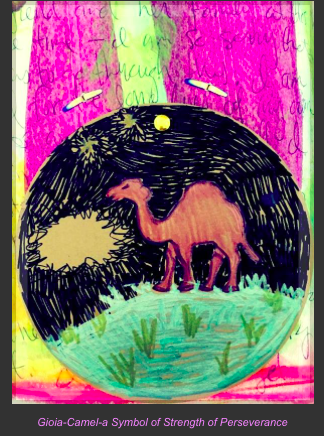Gioia–Symbol of Strength and Perseverance
One of our clients recently added a nuance to our approach to managing stress and developing resilience. She identified that she parses her “toolbox” of coping strategies into two categories–techniques she uses “in the moment” when she’s faced with something really difficult or traumatic, and ongoing routines that she employs preventively to keep herself stable and well.
This differentiation struck us as critical because the strategies we use may be different for each category. For example, Rebecca’s husband KC’s method of coping when he’s had a really rough day or something bad has happened to him is to buy a stash of chocolate (junior mints and peanut m&m’s) and head for the movies. You could call this escape, and it is. But distraction is not always a bad thing. In fact, positive distraction is a very effective coping strategy when it is not harmful (to self or others) and it doesn’t perpetuate longer-term avoidance, suppression, or dependency that would become a problem in-and-of itself.
Rebecca’s “in the moment” strategies include reaching out to others, cuddling with her cats, and sleep. For Gioia, it’s taking a bubble bath, reading a novel, and also sleep.
It may be obvious that we would want to have techniques that help us when we are in acute distress–we’re in pain and we need some kind of relief! It is also self-evident that we want to reduce stress in the long run because we know it is not only unpleasant but unhealthy. But perhaps more compelling is that preemptively managing stress helps reduce the force and depth of its impact and its helps us bounce back more quickly when it comes along.
We have a handout here that outlines nine key strategies for managing stress. We suggest that you identify 2-3 which have the most impact on your wellbeing. For KC, it’s staying connected to meaning and purpose and when he runs into setbacks, taking stock of what he can effectively change about the situation and working on accepting what he cannot. For Rebecca it’s self-care–sleep (which, as mentioned above, she also uses for coping “in the moment”) and exercise–and, because she is prone to anxiety, actively increasing positive emotions and experiences. For Gioia, who is more naturally positive and resilient, it’s being engaged and in flow by utilizing the strengths that energize her.
We recommend that you really focus your efforts on those strategies you know are the most important for your long-term health–maybe it’s yoga, meditating more and/or focusing on your breathing, taking time to attend more to the good, identifying and using more of your signature strengths, engaging in more spirituality, identifying your mission and vision, putting into writing or artwork difficulties you’ve struggled with, or connecting more regularly with key supportive people. Implement these few essential practices not just for a week or a month, but six months, a year, or even a lifetime. It’s a long-term investment that we can assure you will pay off.
We also suggest you think back to times that have been really stressful and make a list of what helped get you through “the moment”. From that list, highlight those strategies which were the most helpful and healthy. Keep it with you for the next time things get tough. If you’re in DC April 27, come to our workshop at Smith Center on “Honoring Resilience and Perseverance” (click here for more info). We’ll be celebrating our capacity to survive and thrive in the face of adversity.
Warmly, Rebecca and Gioia
Art Directive
Make a collage of things that are comforting to you and help you cope “in the moment”. Make another collage of strategies you use to manage stress in the bigger picture. Compare the two. What insights emerge? Feel free to share your image or your thoughts here on our FB page. We’d love to see them!
